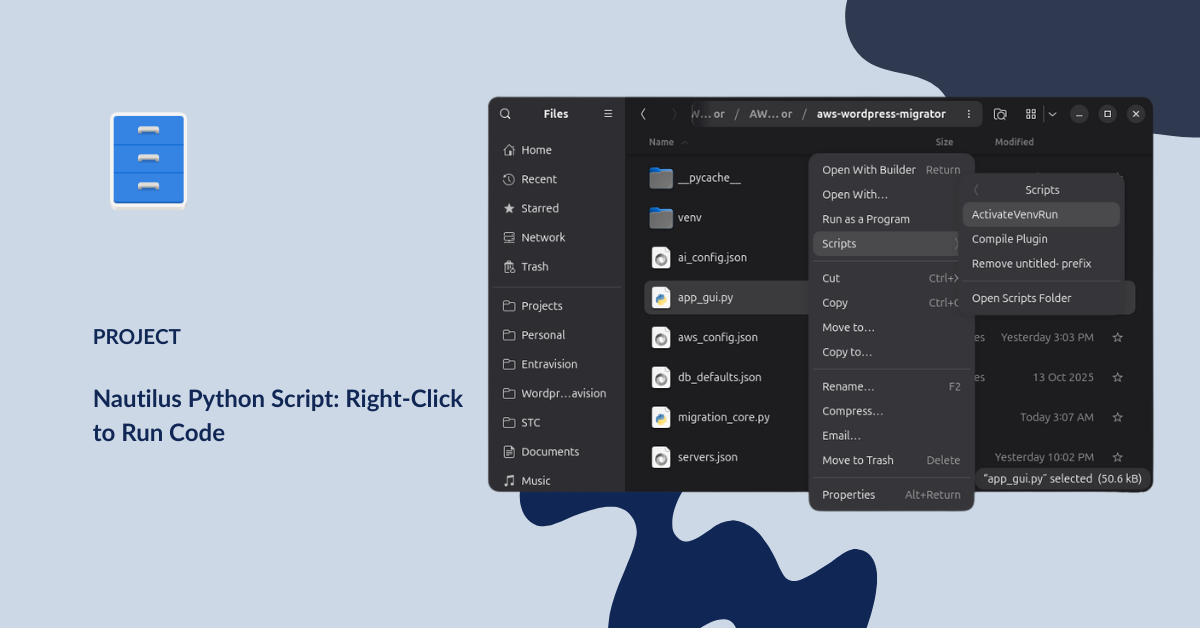Right-Click to Run Python on Ubuntu (Nautilus Script Guide)
Want a faster workflow? This guide shows how to create a Nautilus right-click action that activates your virtual environment and runs any selected Python file—no extra typing. Learn how to build a simple nautilus python script and save time on every project.
Why nautilus python script Matters
Ubuntu’s Files app (Nautilus) supports custom scripts that appear in the right-click menu. By adding one that finds your nearest virtual environment and launches the selected .py file, you eliminate repetitive commands and misfires. For background, see Python’s venv docs and the GNOME Files (Nautilus) help. For Linux setup tips, browse more on Linux Tutorials.
What You’ll Build
A Nautilus script named ActivateVenv_Run that:
- Detects the file you right-click (e.g.,
app_gui.py). - Walks up parent folders to find a venv named
venv,.venv, orenv. - Activates that venv and runs the file in a new terminal window.
Step-by-Step Instructions
1) Create the Nautilus scripts folder
mkdir -p ~/.local/share/nautilus/scripts
2) Create the script file
nano ~/.local/share/nautilus/scripts/ActivateVenv_Run
3) Paste this Bash script
#!/bin/bash
# Nautilus script: Run selected Python file inside nearest venv (.venv/venv/env)
# Get first selected path from Nautilus (newline-separated list)
SEL="$(printf '%s' "$NAUTILUS_SCRIPT_SELECTED_FILE_PATHS" | head -n1)"
# If nothing selected, show message and exit
if [ -z "$SEL" ]; then
gnome-terminal -- bash -lc 'echo "No file selected."; exec bash'
exit 1
fi
# Resolve directory and filename
if [ -d "$SEL" ]; then
DIR="$SEL"
FILE=""
else
DIR="$(dirname "$SEL")"
FILE="$(basename "$SEL")"
fi
# Only run if a .py file was selected (loosen if you want)
if [ -n "$FILE" ] && [[ "$FILE" != *.py ]]; then
gnome-terminal -- bash -lc "echo 'Selected file is not a .py file: $FILE'; exec bash"
exit 1
fi
# Open a terminal, locate a nearby venv, activate, and run the file
gnome-terminal -- bash -lc "
set -e
DIR=\"$DIR\"
FILE=\"$FILE\"
# Find nearest venv by walking up to /
VENV=\"\"
SEARCH_DIR=\"\$DIR\"
while [ \"\$SEARCH_DIR\" != \"/\" ]; do
for V in venv .venv env; do
if [ -x \"\$SEARCH_DIR/\$V/bin/python\" ] && [ -f \"\$SEARCH_DIR/\$V/bin/activate\" ]; then
VENV=\"\$SEARCH_DIR/\$V\"
break 2
fi
done
SEARCH_DIR=\"\$(dirname \"\$SEARCH_DIR\")\"
done
if [ -n \"\$VENV\" ]; then
echo \"Using venv: \$VENV\"
source \"\$VENV/bin/activate\"
PY=\"\$VENV/bin/python\"
else
echo \"No venv found; falling back to system python\"
PY=\"python3\"
fi
cd \"\$DIR\"
if [ -n \"\$FILE\" ]; then
echo \"Running: \$PY \$FILE\"
\"\$PY\" \"\$FILE\"
else
echo \"No file selected; opening shell in \$DIR\"
fi
echo
echo \"--- Finished (interpreter: \$PY) ---\"
exec bash
"
4) Make it executable
chmod +x ~/.local/share/nautilus/scripts/ActivateVenv_Run
5) Restart Nautilus
nautilus -q
Close and reopen the Files app. (If needed, log out/in.) See Ubuntu’s guidance on restarting processes: help.ubuntu.com.
6) Use it
- Right-click any
.pyfile (e.g.,app_gui.py). - Go to Scripts → ActivateVenv_Run.
- A terminal opens, your venv activates, and the script runs.
Troubleshooting
- “No venv found”: Create one with
python3 -m venv .venvthensource .venv/bin/activate. - Different terminal app: Replace
gnome-terminal -- bash -lcwith your favorite (e.g., Kitty or Tilix). - Run non-.py files: Remove the file extension check in the script.
With this setup, running code is one right-click away. If you found this helpful, explore more automation guides in Linux Tutorials and related topics like Bash Script and Virtualenv. This guide is published by Erick Castillo to streamline day-to-day dev workflows.

